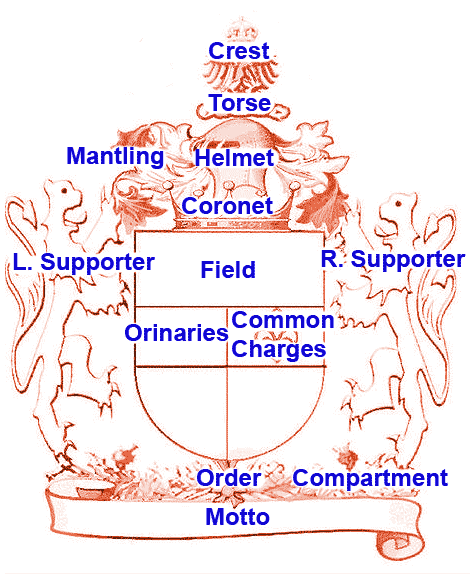Civic Arms – General
 In the 12th Century, defensive body armour used by knights had reached the level where the complete body was fully encase in armour, complete with full facial helmet. The downside of this is that it was not easily possible to identify anyone on the battlefield.
In the 12th Century, defensive body armour used by knights had reached the level where the complete body was fully encase in armour, complete with full facial helmet. The downside of this is that it was not easily possible to identify anyone on the battlefield.
The practice was soon established of wearing ‘colours’ that could easily be recognised; most particularly, a large shield. Initially, simple shield designs making use of two or so colours were used but soon, shields began to bear symbols or ‘Charges’ such as an Eagle or Lion. Matching colour ‘Crests’ worn by a knight on top of his helmet also became of great significance.
The design featured on the Shield was ‘blazoned’ on a colourful fabric ‘Tabard’ worn over the Knight’s armour from which the expression ‘Coat of Arms’ was derived.
Heralds were soon established, around 1150 AD, as experts who kept records of all such ‘Bearings’ and who they officially belonged to allowing knights to be recognised by the arms they bore on their shields and the crests they wore on their helmets. Heralds soon acquired an expert knowledge of these and became responsible for recording arms, and then later for regulating and controlling their use.
Heraldry, under official control, became the means of identification of leading combatants in mediaeval warfare. Initially, only the higher nobility used Armorial Bearings but gradually, the practice spread downwards through the ranks and the Mediaeval Crusades and frequent wars did much to spread the usage and popularity of Armorial Bearings and it quickly spread through the whole of Europe.
By the 16th Century, the use of body armour had greatly declined as foot-soldiers were replaced by artillery and firearms. The golden age of military heraldry had been and gone but heraldry was by then well embedded in the class system and Arms had become very elaborate and extended to ‘Regalia’.
Civic arms eventually became established with Arms being granted to cities or towns rather than to individuals for civic usage.

